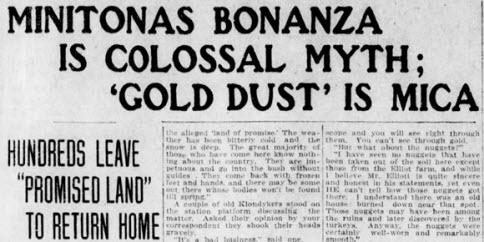by Bruce Cherney (part 4)
The January 1912 Minitonas turkey gold rush ended just as abruptly as it began. In the aftermath of it having been determined that the rush was a bust, people, especially the hundreds lured to the community by tales of pieces of gold found in a turkey crop, were demanding an explanation of how the hoax had been perpetrated in the first place.
It was as if the gullible were seeking an answer to explain away their own gullibility.
“There are several peculiar features to the affair,” reported the January 29, 1912, Winnipeg Tribune. “It is claimed that several innocent parties were used as cats-paws, and that reputable farmers were led to places that had been salted ... These parties would scoop up a shovelful of sand and discover the planted gold.”
The truth of the above statement is suspect, since reports of gold being found were by word of mouth, rather than in the form of physical proof. In effect, the more outlandish the story became to promote the presence of gold, the more it was believed. How else do you explain the buzz of excitement associated with the alleged finding of pieces of gold in a turkey’s crop?
The Manitoba Provincial Police (MPP) claimed that those with the loudest complaints about the failure to find gold were the very people who had promoted the rush. Their protests were an attempt to cover up their own responsibilities for the fake boom, the police insisted.
“An attempt was also made to shelve the responsibility, and the names of innocent parties were adroitly brought into the vortex and the anger of the crowd skillfully directed against them.”
The MPP were said to be initiating an investigation to bring the parties who promoted the false gold rush to justice.
Assayer J.P. Hughes, who was not mentioned by the MMP as being responsible for fomenting the rush, claimed in a letter to the Tribune that earlier statements attributed to him in the newspaper about finding gold in nearly every soil sample he received were exaggerated.
“I still maintain that at least one piece of gold was found on the Weir farm. Of all the samples tested I only told four persons that color and possible fine gold was present in their samples.”
Hughes said that he hadn’t directed a single person to stake a claim, nor did he receive any payment “from any party or parties in this direction.”
Of all the tests he completed, Hughes said he was only paid $2 for assaying one sample.
“If the matter proves a swindle those that were making lots of money will perhaps know more about the matter than I.”
When a train arrived in Winnipeg from Minitonas, 50 men who left the so-called “gold fields” expressed their disgust at being the victims of a colossal hoax. Many of these men, according to the January 27 Tribune, arrived in Minitonas the day before at two o’clock and after looking things over and deciding the gold rush was a bust, took the first train back to Winnipeg. “All were of the same opinion — that there was ‘nothing doing.’”
Even with the outflow of frustrated gold seekers, it took time for the village to empty, and private residences and other facilties, such as the public hall, were still housing many outsiders.
“Within a week the little town of the northern Manitoba foothills will resume its normal aspect, and the gold rush of Minitonas will be a chapter of history ...” (Manitoba Free Press, January 29).
The very fact that the rush was triggered by gold being found in the crop of a turkey(s) should have been the first clue that it was nothing but a swindle being perpetrated on the gullible.
In fact, an investigation of the gold from the fowl showed, “They were probably melted imitation gold trinkets ... (and) that they were probably rooted by the turkeys out of the ruins of burnt house nearby” (Tribune, January 31).
But a later investigation would reveal that the alleged yellow-coloured metal in the turkey’s crop wasn’t even imitation gold.
Furthermore, the newspaper reported the rumour that the “boom” had been “diligently ‘worked’ up by interested parties who seized the opportunity afforded by the turkey discovery ...”
(Next week: part 5)



